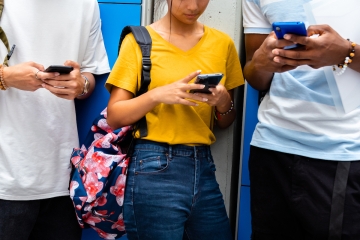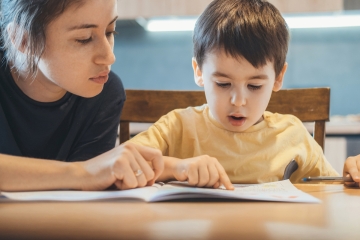Editor’s note: This was first published on the author’s Substack, The Education Daly.
They’re coming for the kids’ phones. Who is “they”?
Governments, for starters. There’s a national U.K. effort to forbid phone usage by students during the school day. Bans have already been implemented in France and China.
Next up, we have the professors. Dozens of prominent academics, including Jonathan Haidt, sent a letter this fall to U.S. Secretary of Education Miguel Cardona calling on him to issue an official advisory asking schools to adopt phone-free policies. They argue that personal devices are generally unhealthy for kids, but particularly so when they are used during the school day.
Finally, the editorial boards. In the past two months, Bloomberg and The Washington Post have called for bans on phone usage during the school day, with the Post going even further by advocating that students be forced to leave their devices at home.
Why all the fuss? Turns out, there are good reasons.
Spoiler alert: Solutions are not as obvious as we might wish. We’re dealing with something more than kids watching TikTok during science class.
The case against mobile phones in school
Those hoping to ban phones see them as an unhealthy interference with nearly every key function schools are meant to serve. They argue that:
- Just as more kids began spending more time with their phones, we saw a massive spike in depression and mental illness. By 2012, major social media platforms had become particularly engrossing/addictive by adding features such as likes and retweets, then coding sophisticated algorithms that massively increased the length of time users would remain engaged. By 2015, most American teenagers had smartphones. In the years to come, nearly every indicator of youth wellness worsened. It happened in one developed country after another, where technology adoption occurred at the same clip. The share of adolescents reporting high levels of loneliness, for instance, doubled in less than a decade. Psychologist Jean Twenge, whose early work on this issue was often dismissed as alarmist, has proven terribly prescient. She and others say that while we may not be able to keep kids away from dangerous social media all the time, the least we can do is to make schools a respite.
- Phones prevent socialization between students during school. Ask a veteran teacher what’s changed in recent decades, and the first thing they’re likely to mention is kids not talking to one another anymore. Some can barely initiate or sustain a conversation with a same-age peer. They don’t have the practice. Others wear AirPods like security blankets. Phone bans are seen as restoring critical interactions that kids missed—to their lasting detriment—during Covid closures.
- Despite what rules may exist, most students are using their phones during school. In a study conducted by Common Sense Media—which does fantastic work on this issue—97 percent of kids aged 11–17 were on their phones between 8 a.m. and 3 p.m. on school days for an average of forty-three minutes. They typically picked up their phone thirteen different times. The most frequently accessed apps were social media. To fed-up policymakers, this is evidence that guardrails on student phone usage have utterly failed. It’s time to get serious.
- Phone usage reduces learning. You may be aware that we’re experiencing something of a learning crisis since the arrival of the pandemic. It’s bad. We need to maximize every tool to help students recover. In classrooms where phones are permitted, students perform worse—even if they are not among those using a device. This may suggest that distraction is contagious across whole groups.
To sum up, there are loads of reasons to keep kids off their phones during class. I tried to find dissenters who took the opposite position—that phones are relatively benign and we shouldn’t bother trying to keep kids from using them during school. But, honestly, I couldn’t find anything worth sharing with you. (Feel free to send me good stuff you’ve run across. I know the dissenters are out there!)
The policy options
Ok, if we’re going to do a phone ban, what does that look like? Schools commonly choose one of three rules:
- Students can’t bring their phones into the school building. Phones stay at home. There are obvious issues with this approach. Parents want to be able to track their kids to and from school to ensure safe travel. They want kids to be able to call them if they have a bike accident or need a ride home after school. Many students go directly from dismissal to pick up siblings at other schools or to extracurriculars where they may need their devices. Some kids do not carry cash—rather, they pay only through apps on their phones, and they need to be able to purchase things after school for themselves or their family. Just a ton of things going on here. So why are some schools—indeed, some countries—going this way? Because it simplifies enforcement. Some teachers appreciate that. If there are no phones in the building, teachers don’t have to collect them or remind students to put them in their lockers. Additionally, if the phones aren’t in the building, they can’t relay text messages or notifications to smart watches kids are wearing. Regardless of the merits of this approach, principals are likelier to win a fight with a car full of wolverines than to get parents to send their kids to school phone-less. It’s a tough sell.
- Students can’t have their phones in class. They must be checked into a pouch/holder under the teacher’s supervision or left in a locker. Usually, this means bell to bell. Students cannot access phones at lunch or recess. This approach avoids some of the sticky problems of the previous policy while making it reasonably easy for teachers to see whether a student’s phone has been surrendered or not. The downside is a somewhat greater burden of enforcement, which introduces the possibility of inconsistency from one homeroom to another. Nonetheless, this is the policy that seems most popular these days.
- Students can’t use mobile phones in class. It’s fine to have the phone—it just needs to stay in a pocket, backpack, etc. Can’t be out on the desk, can’t be actively streaming music to a student’s headphones, can’t be capturing video of a kid drooling through his nap at the next desk. This one requires a substantial level of teacher enforcement, which quickly becomes exhausting. Many teachers simply give up. It’s comically easy to thwart. Kids ask to use the bathroom and sit in the toilet stall for twenty minutes enjoying the algorithm’s greatest hits. This policy still has its supporters, though, because it is least likely to lead to confrontations with angry parents who want their children to be reachable at all times. It’s probably the least popular option with teachers.
Other stuff nobody wants to talk about
What struck me in my conversations with educators and parents about phone bans is how little they talk about phones. Or social media. Instead, there are two issues they bring up repeatedly.
First, accountability and consequences for students. The key thing about any cellphone policy, as you probably picked up in the section above, is enforcement. Teachers don’t want to spend all day policing phones. It’s awkward. It’s infantilizing. It can escalate. For some kids, having something cherished taken from them puts them in a very defensive, anxious position. Power dynamics across lines of difference zoom to the fore. Parents get really angry. Administrators often won’t back teachers who enforce the administration’s own policies.
And yet: Without consistent enforcement, none of these cellphone policies mean anything. I had many exchanges with current and former teachers. When I asked them which policy they preferred, by far the most common answer was “the one that will be enforced.”
We are living through a moment when punishing students—including things like confiscating their cellphones—is out of vogue. Schools have heard loud and clear that students are struggling, they are fragile, and the priority is to build relationships. To make students feel welcome. Punitive discipline is alienating.
District, state, or national phone bans might give cover to schools to do more enforcement. But in a hyper-decentralized system like ours, schools are going to do what they want to do. There’s a tension between the prevailing desire to lighten up on discipline and the need for consistent enforcement if we want fewer phones in class. Shouldn’t we discuss that openly?
Second, we have a broader problem with student presence. Lots of kids aren’t even showing up to school. When they do, it’s gotten harder to earn their attention because there is more competition for it. Phones are just one element—one that schools may control through a ban. But school-sponsored technology in the classroom is whopper of a challenge, too. Conservatively, 80 to 90 percent of schools have 1:1 computing. Tablets and Chromebooks can do many of the same things as smartphones—and kids have full access to them throughout the day. Unable to text one another because their phones are stored away, students open shared Google docs and send messages to one another that way. Easy. They rush through activities to play games. You might think the IT department would block kids from accessing game sites, but software companies cleverly disguise non-nutritional content as “educational.” (Check out this example. If this is math instruction, bowling is CrossFit.)
Matt Kraft and his colleagues have done great work explaining how the value proposition for the American teacher seemed to deteriorate beginning in 2010 or so. They cite a number of compelling explanations. I submit that we cannot overlook how much of it is due to teachers competing for student mindshare. It’s no fun when half your class isn’t truly there. Banning cellphones won’t solve that problem. Districts may need to ask themselves difficult questions about the tens (or hundreds) of millions of dollars they have invested in screens.
What should we do?
OK, let’s ban students from using their phones during the school day. I’m sold. That’s probably the easy part. How can this policy be implemented so it works?
Schools should invest in secure, signal-blocking pouches from a company like Yondr. That way, devices stay with the students but they cannot be used. Less for teachers to police. At the end of the day, students can unlock the pouches and access their phones. No need to return to a homeroom where the phone is being stored; unlocking stations can be made available after the final bell in every classroom and exit. If it works at Madonna concerts and Chris Rock comedy shows, it can work in schools. Districts like Springfield, Massachusetts, are reporting positive results. Others, like Richmond, Virginia, are signing on.
But let’s establish rules for adults—not just students. If enforcement of phone policies is essential, insist teachers take the appropriate action each and every time they encounter a breach. We do this with plenty of other high priorities. Teachers can’t ignore bullying or physical violence. They can’t let kids cheat on state tests. They shouldn’t ignore phones, either. Teachers will have an easier time explaining a phone confiscation to a parent if they can point to a district directive. Hold teachers accountable on performance reviews if they are undermining the school’s campaign for phone-free learning.
Next, attach a reasonable and meaningful penalty to violating school phone rules. It should be commensurate with the magnitude of the offense. To date, it sounds like most schools treat this as pretty low magnitude. I’d say we need to bump it up a level so there is a bit more deterrence. Medium magnitude. Don’t just take the phone and return it at the end of the school day. That’s when the student was going to regain access anyway if they were following the rules in the first place. It’s not an actual consequence. Ask a parent to retrieve any phone that’s found during the school day where it does not belong. Have the student serve a detention. Don’t go overboard, but make the point.
Finally, don’t lose the forest for the trees. We all want classrooms to be warm, lively, engaging environments where kids can focus on things worth doing. Target all the barriers to that goal, even if they turn out to be iPads, bad curricular materials, boring instruction, negligent classroom management, or low expectations. If we don’t address those things, how can we blame kids for watching TikTok in the bathroom? Wouldn’t you do the same?
Personal postscript
The most enjoyable part of working on this post was hearing directly from students. I had fun conversations with my own kids, who are fourteen and twelve, as well as the children of friends and colleagues. A few of them reviewed early drafts and pointed out all sorts of things I’d gotten wrong. It was a good reminder that we ought to include young people more often in discussions of education policy. If you have an opportunity to talk about cellphones, chronic absenteeism, grade inflation, or any other hot-button issues with middle or high school students, I can almost guarantee it will be time well spent and you will hear things that adults never bring up.






